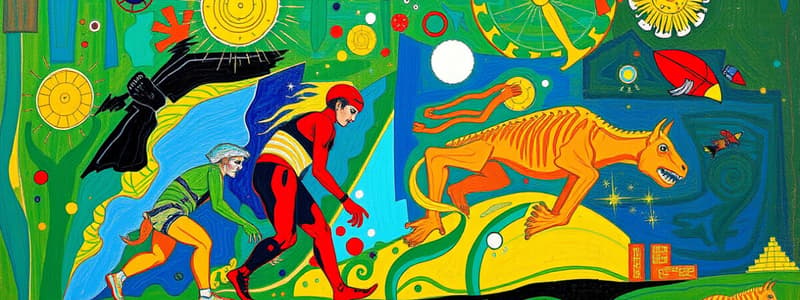Podcast
Questions and Answers
Who wrote the book on the theory of Natural Selection?
Who wrote the book on the theory of Natural Selection?
Charles Darwin
What is the best scientific explanation for both the unity and diversity of life?
What is the best scientific explanation for both the unity and diversity of life?
- Cell Theory
- Quantum Theory
- Theory of Evolution (correct)
- Theory of Relativity
What are groups of interbreeding organisms in the same area called?
What are groups of interbreeding organisms in the same area called?
Population
What happens in a large population concerning evolutionary rate?
What happens in a large population concerning evolutionary rate?
What happens in a small population concerning evolutionary rate?
What happens in a small population concerning evolutionary rate?
What is evolution?
What is evolution?
What is natural selection?
What is natural selection?
What are the four types of polygenic selection?
What are the four types of polygenic selection?
What is an adaptation?
What is an adaptation?
What is reproductive isolation?
What is reproductive isolation?
What are the two main ways to describe the rate of evolutionary change?
What are the two main ways to describe the rate of evolutionary change?
What is gradualism?
What is gradualism?
Approximately how long does it take for gradualism to occur?
Approximately how long does it take for gradualism to occur?
What is punctuated equilibrium?
What is punctuated equilibrium?
When does punctuated equilibrium occur?
When does punctuated equilibrium occur?
Approximately how long does it take for punctuated equilibrium to occur?
Approximately how long does it take for punctuated equilibrium to occur?
Who proposed the term 'punctuated equilibrium'?
Who proposed the term 'punctuated equilibrium'?
What is a vestigial structure?
What is a vestigial structure?
What are homologous structures?
What are homologous structures?
What are analogous structures?
What are analogous structures?
What is common ancestry?
What is common ancestry?
What is divergent evolution?
What is divergent evolution?
What is speciation?
What is speciation?
What is the struggle for existence?
What is the struggle for existence?
What is overproduction in terms of evolution?
What is overproduction in terms of evolution?
What is artificial selection?
What is artificial selection?
What are acquired traits?
What are acquired traits?
What is diversity in biology?
What is diversity in biology?
What is variation?
What is variation?
What is a species?
What is a species?
Flashcards are hidden until you start studying
Study Notes
Evolution Basics
- Charles Darwin authored the book on Natural Selection, foundational to the theory of evolution.
- The Theory of Evolution explains both the unity and diversity of life as proposed by Darwin.
Populations and Evolutionary Rates
- Populations consist of interbreeding organisms in a specific area.
- Large populations exhibit lower evolutionary rates and are more commonly found in fossil records.
- Small populations have higher evolutionary rates, making evolution easier and more rapid.
Key Concepts in Evolution
- Evolution involves a change in variation over time, leading to modern organisms descending from ancient ones.
- Natural selection, known as "survival of the fittest," drives evolution by favoring traits adapted to specific environments.
Types of Natural Selection
- Stabilizing Selection eliminates extremes, favoring average phenotypes.
- Directional Selection favors one extreme phenotype over another.
- Disruptive Selection promotes both extreme phenotypes.
- Sexual Selection influences traits based on male attraction, contributing to sexual dimorphism.
Adaptation and Isolation
- Adaptations are inherited traits enhancing survival chances.
- Reproductive isolation prevents species from breeding successfully due to various barriers, including geographical and genetic.
Evolutionary Change Rates
- Gradualism describes slow, incremental evolutionary change over millions of years.
- Punctuated Equilibrium proposes long stable periods interrupted by brief, rapid changes, often occurring in smaller isolated populations over hundreds of thousands of years.
Historical Contributors
- Niles Eldredge and Stephen Jay Gould introduced the term "punctuated equilibrium."
Structural Evidence of Evolution
- Vestigial structures are remnants of features once useful to a common ancestor.
- Homologous structures showcase different mature forms in organisms that arise from the same embryonic tissues, indicating common ancestry.
- Analogous structures appear similar in unrelated organisms but do not share a common lineage.
Evolutionary Processes
- Common ancestry means a group shares descent from a common ancestor.
- Divergent evolution, or adaptive radiation, occurs when a small group evolves into diverse forms adapted to different environments.
- Speciation is the formation of new species driven by evolutionary changes.
Mechanisms of Evolution
- The struggle for existence highlights the competition among individuals within a species.
- Overproduction leads to more offspring being born than can survive.
- Artificial selection, or selective breeding, involves human choices over which traits persist in a population.
Diversity and Variation
- Diversity encompasses all species on Earth, while variation refers to differences within a single species.
- A species is defined as a group of similar organisms capable of interbreeding and producing fertile offspring.
Studying That Suits You
Use AI to generate personalized quizzes and flashcards to suit your learning preferences.




